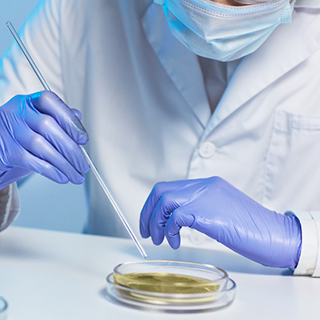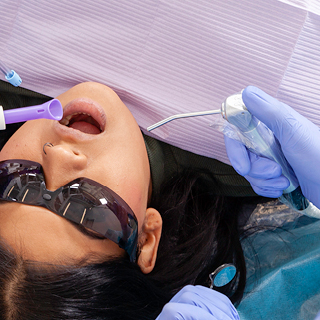Blog
Waterline Testing: What Do You Need to Know?

Follow These Steps for Accurate Waterline Testing Results
With more areas recommending or requiring dental unit waterline (DUWL) testing, the pressure is on dental practices to prove that their treatment water meets current industry standards. It’s important that dental practices follow protocols as outlined in accompanying equipment and product Instructions for Use (IFUs) to achieve the most accurate results. To maintain compliance, it is critical for all staff responsible for Infection Control to have an in-depth understanding of waterline treatment, testing and record keeping.
When there are no manufacturer directions available for testing dental treatment water, the guidance from the Organization for Safety, Asepsis and Prevention (OSAP) 2018 white paper on dental unit water quality recommends that periodic monitoring and inspection should be performed at least monthly on each dental unit or device following installation of treatment devices or initiation of new protocols. If monitoring results indicate that water quality is acceptable for two consecutive monthly cycles, the frequency of testing may be reduced, but should not be less than every three months. This guidance is designed to help dental practices meet the EPA’s current water-quality standard of ≤500 CFU/mL.
Waterline Test Methods
According to both the U.S. Centers for Disease Control and Prevention (CDC) and the American Dental Association (ADA), water in all DUWLs should demonstrate less than or equal to 500 colony-forming units of bacteria per milliliter (CFU/mL).
To measure whether the dental office treatment water is in compliance with the stated CDC levels for CFUs/mL, two types of dental office water tests are available. Let's review the advantages of each.
Mail-in Lab testing
The most precise water test results come from mail-in lab testing, which provides an exact CFU/mL count for each individual water sample (e.g., operatory, handpiece line, air/water syringe).

How It Works
Generally, the process involves collecting water samples, shipping them overnight to a lab and waiting approximately 7-10 days for results. That may sound simple, but if proper protocols are not followed, the water sample may become compromised, impacting test accuracy. To avoid errors, dental staff must do the following:
- Read the Instructions for Use (IFU) and/or contact the test manufacturer to address any questions or clarifications before starting the sample collection process. This avoids having to start over (if performed incorrectly) saving valuable staff time.
- Upon receiving the testing kit, immediately freeze the included ice pack to make sure it is completely solid prior to shipping the collected samples.
- Use aseptic techniques to gather samples:
- Perform proper hand hygiene
- Don disposable gloves
- Clean and disinfect all surfaces in the sample collection area
- Avoid touching the waterline outlet and the interior of the water test vials
- Keep test vials open for as little time as possible
- Flush all lines that draw water from the dental unit for two minutes before sample collection. This includes lines that are rarely/never used (such as side carts, cabinets, scalers, etc.)
Note: DUWLs can be tested individually or as a pooled . However, the pooled sample:
-
- Cannot include more than 10 waterlines
- Must have an equal amount of water from each waterline
- The number and description (i.e.: scaler, AWS, Asst. cart) of the pooled lines must be documented
- Pooling additional notes:
- Although use of this method is widely accepted it is important to understand that if the pooled sample does fail, each of the individual lines that were part of the pooled sample fail. At this point the office would have two options:
- Re-test every line separately to determine which line(s) are failing
- Shock every line connected to water on the dental unit (include ALL individual lines initially included as part of the pooled sample). In addition, to prevent contamination caused by areas of water stagnation not reached by shock or waterline treatments ensure to run shock through infrequently or unused lines (dead legs) on the dental unit
- Ideally unused water lines should be disconnected from the dental unit
- Although use of this method is widely accepted it is important to understand that if the pooled sample does fail, each of the individual lines that were part of the pooled sample fail. At this point the office would have two options:
- The testing lab must receive the water sample(s) within 24 hours of collection. Note: Collect water samples as close as possible to shipment/pickup time to shorten the time between sample collection and lab receipt.
- Store water samples in the refrigerator until they are ready to ship. Never freeze water samples.
- Refer to the Instructions for Use provided with the test kit for next steps if a failure occurs and action is needed.
In-Office Testing
When used frequently, in-office tests are useful screening tools providing pass/fail results identifying warnings of potential biofilm growth issues before they become a serious problem.
How It Works
Read the Instructions for Use (IFU) and/or contact the test manufacturer to address any questions or clarifications before starting the in-office testing process.
Based on the typical in-office paddle style test method (steps may vary based on manufacturer):
- Carefully separate the paddle from the plastic case – taking care to only touch the paddle handle
- Draw water sample into the plastic case using proper water sampling techniques (see above notes specific to pooled sampling)
- Place the paddle back into the case for a set period of time; empty the water, replace the paddle and then incubate the sample at a temperature and time period provided by the manufacturer IFU.
Once incubation is complete, the paddle will display a series of dots that represent microbial colonies. A visual guide with CFU/mL ranges (as opposed to an exact count) is provided for the user to compare against the results on their paddle. In-house test CFU/mL limits vary by manufacturer. The Instructions for Use provided with the test kit include direction for next steps if failure occurs and action is needed.
It’s important to note that some in-office test results may underestimate readings as certain bacteria do not grow on the paddles, making it important to use these tests as more of an indicator of trends rather than a completely accurate snapshot.
Treating Dental Unit Waterlines

Waterline Treatments
The long, dark, moist and narrow design of dental waterlines create the perfect breeding ground for biofilm growth. Untreated procedural water cannot meet current EPA standards for potable water.
When protocols are followed, Germicidal treatments such as continuous (Cartridges), daily (tablets) or periodic (shocks) can help ensure passing waterline test results.
It is important to understand some of the common waterline treatment misconceptions:
Waterline Treatment/Testing Product Instructions for Use (IFU)
Reading instructions can be time-consuming and tedious but glossing over this step can result in improper waterline treatment and unreliable test results potentially placing patients and staff at risk. Dental professionals must read and understand the IFU for all equipment, waterline treatment and testing product. This includes awareness of and following interval waterline treatment and testing instructions (daily, weekly, monthly, quarterly etc.) for all products.
Importance of Staff Training
Training all staff on processes and procedures related to waterline maintenance and testing is essential to infection prevention and control. Documenting these protocols is equally important to ensuring consistent training of new hires, existing staff taking on new responsibilities and temporary staff.
Documentation
Maintaining a protocol binder is the best way to centrally store product IFUs and track waterline testing results, identify problem areas and document that a dental office is meeting water quality requirements.
Take Advantage Online Record Keeping
Did you know that HuFriedyGroup has a GreenLight Dental Compliance Center that offers an online portal for tracking water testing details and maintains current and historical waterline testing results? The GreenLight portal provides resources for water sampling techniques, failed test help, waterline treatment options, industry guidance and much more!
To learn more about the Greenlight Dental Compliance Center and HuFriedyGroup options for waterline treatment and testing, visit HuFriedyGroup.com
